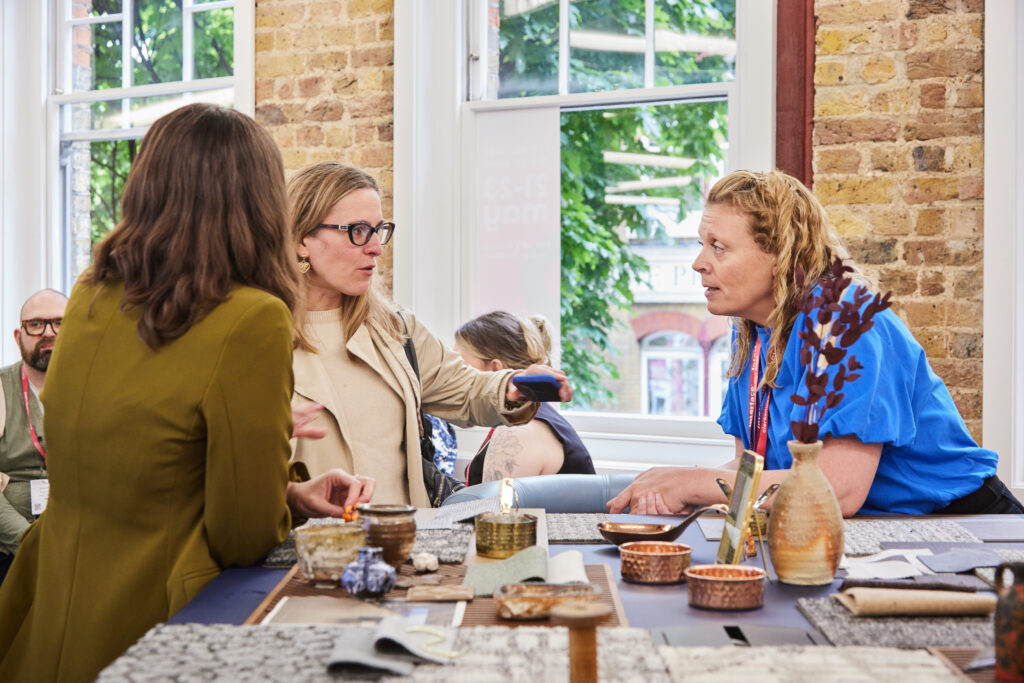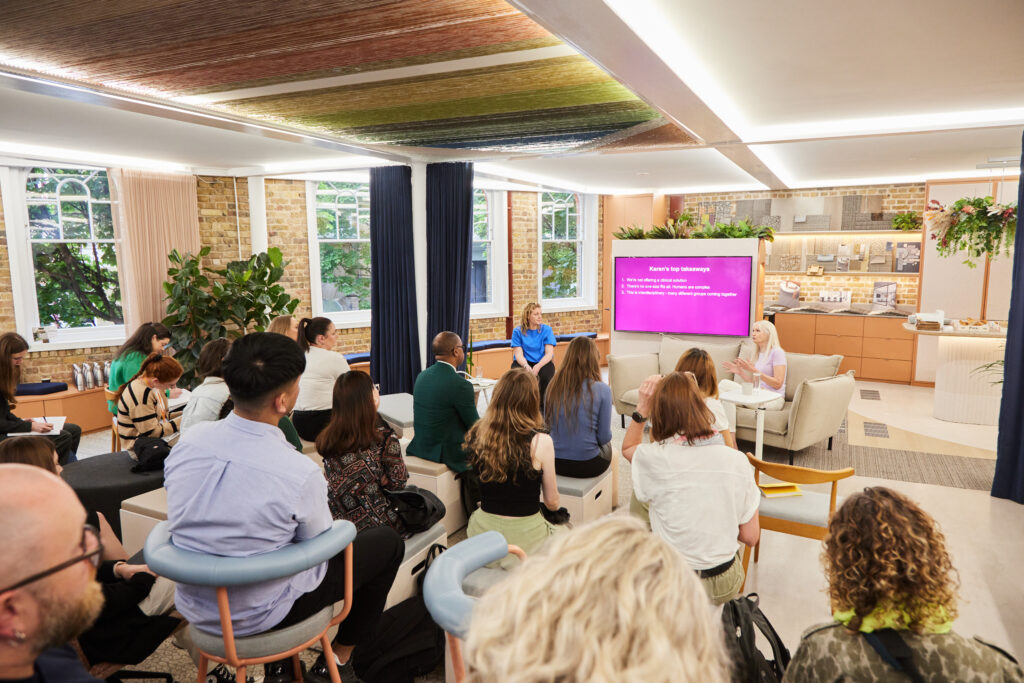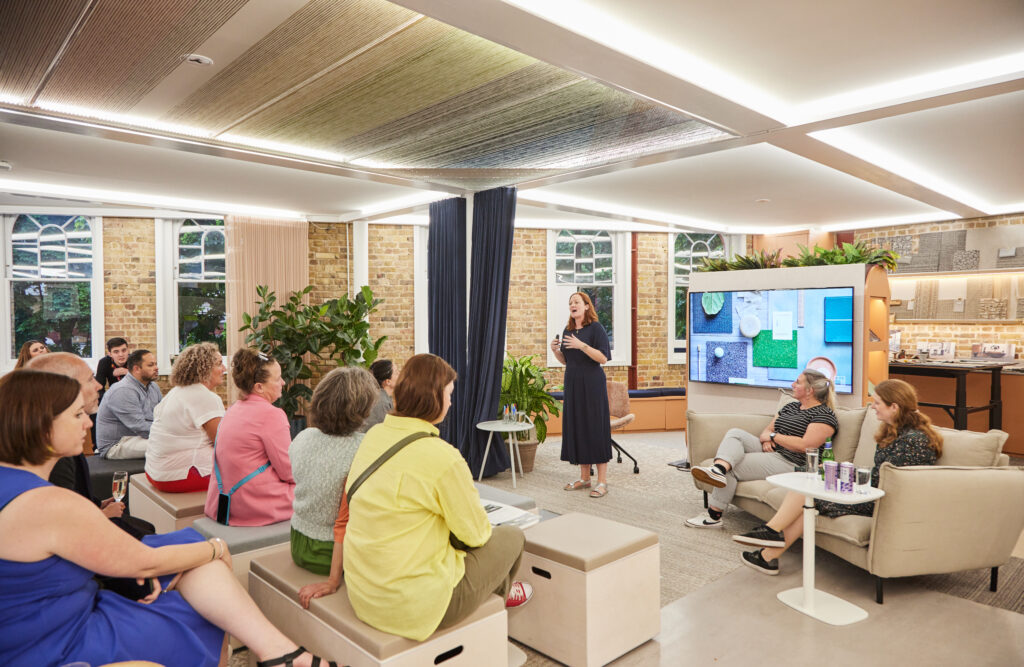Clerkenwell Design Week 2024 is a wrap, and what a week it was!
During this year’s event, our Pennybank showroom was packed full of seminars and workshops discussing the biggest challenges facing today’s designers, including how to use colour effectively in workplace design, and specifying truly circular products. Visitors to the showroom also got an exclusive first look at our new carpet tile collections, Earthen Forms and Etched & Threaded ahead of their official launch later in June.


Every year Clerkenwell offers thought-provoking discussions and endless product inspiration and this year did not disappoint! Clerkenwell also gives our team the opportunity to see how key trends in the industry are developing and gauge emerging trends for the coming years. Here, Laura Light, our Concept Design Team Lead, shares her thoughts on what’s next for commercial interiors.
Using behavioural design to create inclusive workplaces
Demand is growing for designing spaces that focus on how people feel and behave, rather than purely aesthetic choices, for truly inclusive and supportive workspaces.
In our breakfast seminars on Tuesday and Wednesday morning, I was joined by behavioural design expert Karen Haller, where we discussed the importance of designers understanding the behaviours of end-users rather than making emotional, aesthetic-led specification decisions. We discussed the process of colour selection in accommodating neurodiversity and sensory needs, which involves understanding the client’s needs, conducting a thorough analysis of the brief, and then selecting colours based on their psychological impact and harmony to deliver a space that truly supports individuals to do their best work.

And it wasn’t just Interface discussing the role of colour in the workplace – Flokk were joined by colour expert Justine Fox to discuss whether colour amplifies company culture in workplace design, while Emma Bestley, Creative Director at YesColours chaired a session on how the choice of colour can be influenced by emotion and intuition and its impact on the end user.
This dialogue around the impact of colour is only the beginning. As we continue to better understand neurodiversity and inclusive design in the commercial interiors sector, we need to adapt our approach to continue to prioritise the end-user and make our designs as accommodating and supportive as possible.
Truly circular specification
One question on everyone’s lips is ‘how can designers contribute to the circular economy?’.
In our session on Tuesday evening, our sustainability manager Becky Gordon was joined by circular economy designer and lecturer Claire Potter and tp bennett project designer Lucy Bagshaw for an interactive session exploring the circular economy from the perspectives of product design, manufacturing and building.

Circularity was definitely a key focus of this year’s event – with several talks and product launches centred around the principle. Design Council hosted a panel discussion on how to design a world of mass circularity and navigate the issues of less waste going back into production and more raw materials being mined – an issue we explored in depth in our session too. The conclusion? Looking for products that use recycled or bio-based materials rather than virgin petrochemicals helps to reduce environmental impact and contributes to overall circularity on the project.
Several product launches highlighted a dedication to the circular economy too, such as the new Pippin chair by NaughtOne – designed to be completely disassembled at its end-of-life for easy recycling, and its inner casing is free from glues too. The Oru table by Andrev World was also designed with the circular economy in mind, with a low carbon footprint and all components are easily separable and recyclable at the end of life.
Though it’s been refreshing to see circularity discussed so widely at this year’s event, the risk is that the word loses its weight. As designers, we have a responsibility to ensure we ask the tough questions and seek data about where our materials are coming from to be able to provide transparent and measurable specifications that contribute positively to the space.
Exploring the potential of AI in design
AI was another hot topic at this year’s festival, with sessions exploring how designers can adopt the technology to create impressive designs that remain human-centred.
Blum UK hosted a talk on the AI landscape and the opportunities and challenges it poses, while ERCO and Zaha Hadid Architects hosted a series of three talks during the week on technology in design. These sessions explored how AI can be used to create better designs without losing the end-user focus that the industry is rightly shifting towards.
As with every sector, AI will transform our practices in the next few years, but it’s up to specifiers to work with manufacturers, contractors and clients to reap the benefits of the technology and create efficiencies, design boldly and bring visions to life without losing the all-important human touch that we offer to projects.
Watch this space for our upcoming blogs on our Clerkenwell breakfast seminar ‘Colour, behaviour, and the workplace of the future’ and evening event, ‘Closing the gap: A circular approach to design and specification’.